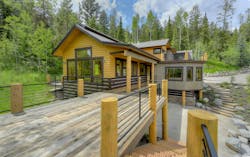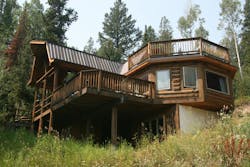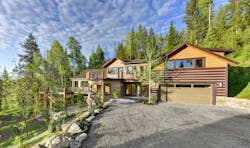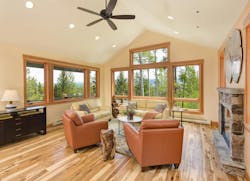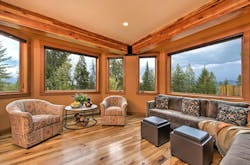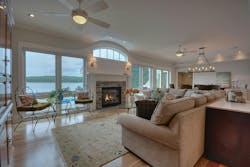Teardown, Salvage, and Design
For preservationists, a teardown can mean a vintage home that exemplifies the character of a neighboorhood will be knocked down to make way for a behemoth of a house. But there also are cases, as profiled here, where a building is so damaged or obsolete that the cost of gutting it versus the expense of building new makes the decision obvious. However, demolition need not be total, as a portion of the original home, such as the foundation or another part of the structure, can become part of the new design.
Here is a tale of two homes that were originally intended for significant remodeling but ultimately were demolished. The first is a Wyoming house on the east side of the Jackson Hole valley that was completely uninhabitable due to mold, rodent infestation, and a foundation on the brink of collapse. The second is a Cape Cod on the Connecticut shore that would have cost significantly more than new construction just to make it sturdy enough to withstand the severe storms in that area.
More Stories About Building on Challenging Sites:
* Laying the Groundwork
* Triumph over Tough Sites
* Resilient Design: Ready for Anything
* Building Custom on a Remote Site
The Mountain House
Ted and Joanne Wong inherited a mountain retreat from Ted’s uncle Ling Tung, who was the music director of what became the thriving Grand Teton Music Festival. The original owner before Tung was a handyman who built the house piecemeal during the 1970s. The building was a log cabin hodgepodge with a dozen elevations, a gambrel roof, and decks adjacent to and on top of an octagonal room that served as a bedroom. The ceilings were very low—so low that the octagon offered a view of the Tetons only if visitors taller than 6 feet bent under the beams to look out the windows. Even the gravel carport below one of the decks offered barely enough clearance for a minivan.
The original Jackson Hole valley house was a hodgepodge of elevations and decks added over the years to an octogonal room.
“It was a crazy hobbit of a house, but it was cool,” says Chris Moulder who stands 6 foot, 6 inches tall and is a principal of Dubbe Moulder Architects, in Jackson, Wyo. “It harks back to how the valley was back then when people would carve living space into every nook and cranny of the valley to have somewhere to hole up for the winter and ski.”
The Wongs wanted to keep the house as an homage to their maestro uncle. The initial plan was to add to it and make the height of the rooms code compliant. But the demolition phase unveiled a cascade of problems.
When builder Pete Welker of Mountain Home Builders, also in Jackson, started the teardown, his crew discovered nests and carcasses of squirrels and other woodland creatures that lived and died within the walls. Later, the crew removed a wood-framed wall built in front of a foundation wall that abutted
the hillside. They unveiled an unreinforced concrete block
wall that was bulging, lacked mortar, and was on the brink
of failing.
Either the handyman owner or a remodeler tried to “fix” the problem by scribing studs against the bulging CMU wall and attaching joist hangers to the studs so they wouldn’t kick out from the bottom plate due to the lateral pressure of the hillside. The main building was literally draped over that wall; it and another lateral shear wall were the only supports holding up the house. Given that the valley is in the same seismic zone as Los Angeles County, in addition to weathering wind gusts and at least four feet of annual snowfall, “the fact that the house was still standing is amazing,” Moulder says. The building was jacked up for about eight weeks while crews worked to excavate the foundation, which was a combination of blocks and hand-mixed concrete. But rain steadily fell during the first two weeks, and the temporary support cribbage started to sink.
“It was really spooky,” Welker says. “We adjusted the cribbage, reshored the house, and started to rip out the foundation with this ominous house just kind of sitting there in the air.”
The new home is three times the size of the original at more than 4,000 square feet. The octagon room was kept in the new design (Photo: LGV Creative)
Black mold was the next discovery, forcing the job to shut down for about three weeks until lab results confirmed the toxic presence of penicillium. Mold mitigation required another three weeks. As demolition proceeded to the kitchen, the crew found 8 feet of ceiling that sloped about 3 inches. At that stage the problems piled up to a point where Welker and Moulder called for a meeting with the owners. Wong, an engineer, accepted the reality that new construction was the more viable and healthy option.
The house was set down and demolished, except for the octagon and a portion of a concrete slab in the basement. Moulder designed a new house that used the existing logs and timbers from the octagon room. However, that part of the home, which now serves as a second bedroom and office, seemed too compressed for a 4,000-square-foot house that is three times larger than the original building. Welker suggested raising the octagon’s ceiling by 3 feet, lowering the floor a foot, and adding new walls and bigger windows.
The open floor plan connects the kitchen to this living room, which includes entryways to outdoor decks on both sides of the house (Photo: LGV Creative).
“Every project that I do, I feel like I’ve got to step back and if there is something too bold or too minute, it’s not going to balance,” Welker says. “The art with remodels or additions is that a portion of the house cannot look like it was an add-on. I think there’s an art to finding that balance and design and craftsmanship to let the project flow nicely and make it feel like it’s all meant to be.” Building new rather than remodeling resolved any issues with updating plumbing and electrical, having the walls and ceilings level and true, and enabled the home to include a two-car garage. The new concrete foundation was built with structural steel and more hold-downs than any other house Welker has built because the seismic, wind, and snow loads on that hillside are “intense,” he says.
The jobsite presented challenges that called on Welker’s problem-solving ability just to get materials there because it was on top of a steep mountain road. When the first snow fell on the project, Welker invited two neighbors on the road to meet his crew at the bottom of the hillside. They critiqued the tires on their vehicles, dividing them into two categories: tires that might make it up the mountain and tires that wouldn’t. That session was Welker’s introduction to the mountain, and he stayed on the neighbors’ good side by regularly plowing and sanding the road.
The octagon room still includes the original timbers after the ceiling was raised 3 feet and the floor was lowered by a foot (Photo: LGV Creative)
But the maintenance didn’t tame the steep road. When the Gradall telescopic handler truck carrying trusses and lumber spun out in the snow, the crew had to shovel sand from the middle of the road into the tracks in order to move the vehicle up the mountain. When the trucks were stuck, the crews boomed out the material as far as the boom would go and then carried the materials by hand or strapped them to a pickup truck and dragged them to the jobsite.
“It was such an interesting project, so much was thrown at me, and it was really just shooting from the hip as we went,” Welker says. “Then the new building went up and came together so nicely.”
Connecticut House
The 1960-ish Cape Cod overlooking Mumford Cove in Groton, Conn., was to be a whole-house remodeling project. But after the new owners calculated the cost of the labor-intensive work just to strip the interior down to the studs, remove and replace all the windows and siding, redo the roof, and take down—brick by brick—the chimney that jutted from the middle of the floor plan, they opted to build anew.
Photos: Kemper Associates Architects.
A teardown and new construction were more feasible, particularly considering the work required to anchor the walls on the old house and add wind shear-control features just to comply with the building code for being within the state’s wind-borne debris zone. Besides, the Cape Cod didn’t take advantage of its location on the waterfront. “It really could have been built anywhere,” says Jack Kemper, principal for Kemper Associates Architects, in Farmington, Conn. “It didn’t take advantage of the views that the site offers and it was very closed in. Every room was a separate room, and the clients were looking for a more open floor plan.”
The retired couple were repeat customers for Kemper and project manager Rich Craine, who designed their main home in Simsbury. The 3,582-square-foot Groton home eventually will become their main residence with space to accommodate the couple’s adult children and grandchildren for visits to the shore. The existing structure was torn down to the concrete foundation, so the new build required just minor additions, such as adding footing to enlarge the two-car garage to a three-car garage.
“We didn’t change the footprint of the building enough to require any additional salvage or reuse of the existing walls,” says builder Nick Uccello, principal of Uccello Development, in Rocky Hill, Conn. “Some coastal towns in Connecticut require that you leave one wall up, which would have been problematic. They figure that if one wall stays, the builder won’t encroach on the neighbor on that side and overbuild.”
Tearing down the chimney opened the floor plan so there are no focal points in the great room competing with the view of Mumford Cove and the direct-vent gas fireplace.
The owners also decided to keep the original pool. Building a new one would not have been an obstacle for Uccello, but obtaining permits to excavate for a new pool would have been difficult and time consuming, as Coastal Area Management authorities would require documentation verifying that the pool was outside the high-water mark and studies to determine if pool construction called for significant sedimentation control. “I don’t know if the [existing] pool is where it needs to be for a new permit, but fortunately, I never had to look into it,” Uccello says.
Before demolition, Uccello and the homeowners saved the fireplace mantel, which was repurposed as a headboard in the master bedroom of the new house. The kitchen cabinets were reused in the garage. Most of the salvage opportunities involved landscaping. All the blue stone from the old house was used for the patio next to the in-ground pool in the rear of the house and for the front walkway.
All lights in this Connecticut shore house are LEDs and the kitchen flooring is 5-inch character grade white oak with a natural finish.
A structural engineer was part of the team and designed the house to withstand hurricanes. The builder installed hold downs and a 31-foot steel beam running along the center of the house from the living/dining room to the kitchen with an 18 ½-foot open span between two columns. The beam acts as a shear wall and creates rigidity for the house.
Also, the ceilings are 9 feet high, compared with 7 ½ feet in the original house, which had a second-floor porch that inhabitants accessed by climbing out a window. Kemper designed a sunroom in that space, leading to a code-compliant deck with stairs that descend to the pool and patio. Impact-resistant windows with stainless steel hardware offer more storm protection, and PVC trim was installed on spots near the ground, on window sills, drip caps, and other areas where moisture can pool and cause trouble. The exterior is clad with prestained white cedar shingles.
“It’s something we know is going to weather, and that’s kind of a nice look,” Kemper says. “The house doesn’t need to look like the day they moved in for forever. We’re OK with the house showing its age.”
A view from the second-floor deck, which includes a stairway leading to the stone patio and pool below.
The Rocky Road to a Deconstruction Permit
Jeff Santerre, co-principal and founder of Prestige Residential Construction, wanted to get a jump on tearing down a 1930s brick house so he could start construction before Seattle’s rainy fall and winter seasons ensued. Yet demolition permits typically are not granted without approving a building permit. The initial review for a demolition permit alone could take two to three weeks—longer for more complex projects—and corrections could add at least another four weeks to that.However, the review process for a deconstruction permit takes as little as two days. Seattle amended its ordinances in 2009 to allow a house to be taken down before issuing a building permit in order to provide an incentive for materials to be salvaged, reused, and recycled. The city’s department of planning and development requires that at least 20 percent of the teardown’s building materials by weight be reused, and 50 percent of the remaining materials—except for asphalt, brick, and concrete—be reused or recycled. The deconstruction permit calls for reuse or recycling of 100 percent of asphalt, brick, and concrete.Santerre has been recycling metal and other building materials from his teardowns since the 1980s and repurposing items such as doors, millwork, light fixtures, and cabinetry in his custom homes. On this project, the house was covered with lead paint, so much of the woodwork wouldn’t qualify toward a deconstruction permit.“We were working very hard to find enough stuff to qualify us," Santerre says. “Then our landscape architect said, What about all these landscape rocks that are around the site? He said, ‘They’re great rocks. You can repurpose them and put them here, here, and here.’ Oddly enough, the landscape rocks are what qualified us. They weighed a thousand tons compared with the bricks in the foundation, which was the only other stuff that we were recycling anyway. That put us over the top for the percentage of weight for the house—and the rocks look great.”
